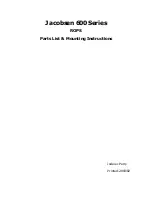
Before unwrapping and starting the mixer there are a few thinks you should know…
Setting input levels: Gain pot adjusts the input sensibility or so to speak the level of the input
signal inside the mixer. It is paramount to set the right input level on every channel.
Why is so important setting the correct input level?
First, we have to understand the concept of Dynamic Range of an audio signal. The Dynamic
Range of an audio signal is defined as the ratio between the maximum level before distortion and
the minimum audible level. It is measured in decibels and gives us an idea of the amplitude of the
signal.
We want the audio signal to fluctuate away from the
maximum level (distortion begins) and away from the
minimum level (or background level), where some
noise is present due the nature of the ICs used in the
electronic circuit (all ICs induce noise into the audio
signal).
At the draw, we depict this “safe” level within two
discontinue lines.
We have to set the level of input signal so that the signal
peaks do not reach saturation levels and the lower
amplitude parts of the signal are not too near the
background noise level.
We have to acknowledge that a professional audio system is a serial bounded group of
professional audio devices and that saturation or other signal deterioration present in one device
will appear someway or another at the serial bounded following devices.
If we deliver saturated signal from the mixer to the power amplifier we will not be able to get rid of
this saturation whatsoever. The power amplifier will amplify all what is given and if noise is given
(saturation at mixer), it will be amplified. Naturally, that is bad.
Power amplifiers and loudspeakers: Current professional power amplifiers are quite reasonably
protected against signal deterioration and excessive levels and shortcuts. Loudspeakers are not
that well protected, hence a rule or some must be devised to use the correct speakers with a given
power amplifier.
Well, that rule is not a straightforward statement but more of an understanding of the principles
and nature of the audio signal. The nature of the audio signal reefer to the type of music you are
playing and more specifically of its Dynamic Range. The bigger the Dynamic Range the bigger
the power amplifier needed. If the Dynamic Range of a give audio signal is big, the difference
between the minimum level and maximum level of this audio signal will be big as well. Therefore,
we will need an oversized power amplifier with enough power to amplify the maximum levels
without reaching the saturation level at the power amplifier (normally, power amplifiers have red
LEDs to let you know when they start saturating).
As a vague rule we can say that Rock and highly compress music require a power amplifier
delivering a power value slightly bigger than the rated maximum power of the speakers. However,
we recommend the power amplifier rated power be 1.5 times bigger than the rated maximum
power of the speakers. Example: if the power amplifier rated power is 200W RMS at 8 , the rated
maximum power of the speakers should be 200x1/1,5=133,4W RMS at 8 .
Using the power amplifier: Saturation and input levels.
In order to make the most of your power amplifier you must watch two things:
1- Set the volume controls in a way that the saturation LED lights up only occasionally (peaks).
2- Feed the power amplifier with an audio signal of the appropriate level. What is the appropriate
level? Professional Power Amplifiers are set for an input level of 4 dBu. Do not panic, it is easy to
get to it. 4 dBu is just a fixed measure of the audio signal that professional audio community uses
as reference level, it can be expressed also in Volts 4dBu equals 1.23 Volt RMS. So to speak, the
Power Amplifier will work at its best if feed with a signal of a level near the 4 dBu or 1.23 Volt
RMS. How do we set this level? Easy, using the mixer appropriately. Incidentally, the nominal
level for a professional audio mixer is also 4dBu. Therefore, if we set the master output level of the
mixer carefully monitoring the output level meters (normally LED bars), we will ensure that the
level of the audio signal fed to the Power Amplifier is near 4dBu because the nominal level of the
mixer is 4dBu and we set correctly the output level or the mixer.
Why we should avoid saturation?
Obvious reasons aside there is a more “material” reason. Saturated signal can damage your
speakers. Although some speakers have overload protection, a highly saturated signal can deliver
D.C. and this phenomenon can easily shatter your speakers.
Ω
Ω
ACCESSORIES
(1) Operating Instruction 1 pc
(2) Switching Adaptor 1 pc
(3) LED Searchlight 1 pc
E
NGLISH
2
1
5 min, Rea
d
me!
Minimum audible level
Pic (Transient)
Electroacoustic Signal
Time
Level
or
amplitude
0
1
2
3
4
5
6
7
8
1
2
3
4
Ratio: Max. Level vs. Minimum audible level
Dynamic Range
Dynamic range
SAT
U
RA ION
T
S
IGNAL
DYNAMIC
RANGE
HEADROO
M
RA
TIO
S
IGNAL/NOISE
!
NOISE









































